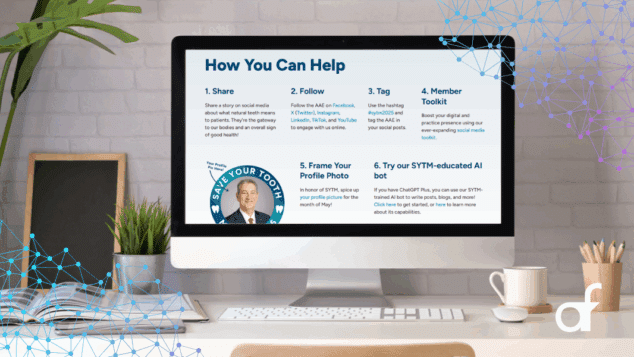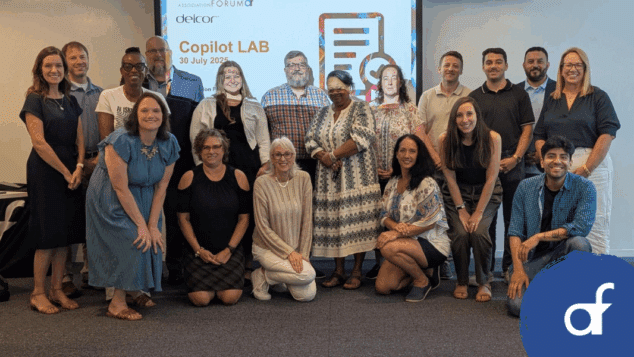What CEOs Need to Understand About Their Technology Executives
With digital transformation pushing organizations to analyze their technology platforms, it is crucial that CEOs learn to collaborate.
By Heidi Weber, MBA, CAE With contributions from Bill Bruce, MBA, CAE, James D. Gibson, PMP and Katherine Matthews, CAE

The bridge between what a CEO expects from an association’s technology chief, department and partners may be wide and confusing. With digital transformation pushing organizations to analyze their technology platforms, it is crucial that CEOs learn to collaborate with not only their technology executives, but also the strategic partners who help provide member value. FORUM asked four association professionals to share insights about how to leverage the CEO-Technology Executive-Partner relationship in order to propel the organization forward.
 Bill Bruce, MBA, CAE
Bill Bruce, MBA, CAEChief Executive Officer
American College of Occupational & Environmental Medicine
Bill Bruce, MBA, CAE is responsible for the overall operations of ACOEM’s headquarters. He works closely with the ACOEM president, board and staff to ensure that ACOEM is true to its mission, vision and strategic inventory. Bruce has nearly two decades of experience in executive roles for medical societies. He earned his MBA from the Robert H. Smith School of Business at the University of Maryland and is also an ASAE Certified Association Executive. He can be reached at bill@acoem.org.
After a decade and a half leading technology for two major medical societies, I can speak from experience on many issues facing senior IT leaders when it comes to supporting their organizations, their CEOs and their boards. Now, as a CEO, I can offer this advice to peers.
Nobody ever joined a society because they have great technology.
CIOs and CTOs may have a difficult time accepting this. So might other executives who are enamored by the promise of technology. The fact is that for most organizations, technology is not the “closer” that we all want it to be. BUT lousy technology can be a significant factor in limiting member value delivery. Forcing members to interact with your organization via inferior technology can be a driver of poor member retention and is a driver of poor member experience. IT leaders may themselves miss the difference here and oversell the upside of IT investments. Today, the value of IT is in fortifying value delivery and preventing downside effects.
Your IT team might harbor stronger business talent that you or others assume.
If your organization has a moderately mature and sophisticated IT ecosystem, the chances are that you have IT staff who can hold their own with a line of business pros in other areas of the organization. If IT staff have done their job, then they had to understand many aspects of the business to get your IT systems up and running. They may be a good source of creative ideas on business process improvements and can likely challenge the status quo for business units they support, which may be getting stale. Successful IT teams know how to partner with other business units and tend to take on more understanding of the work done by those non-IT teams than they get credit.
Good technology executives know how to communicate without depending on jargon, buzzwords or other crutches.
This is because good IT executives see themselves as part of the business leadership team. Like a good CFO or COO, an IT executive should be able to meet on the same level as any of their peers. They should earn the trust and respect of others through their ability to partner on shared objectives. CEOs should be willing to enable their technology executives by granting them parity at the executive table. IT executives are the ones who should be planning the roadways between your business units and members and need access and accountability to do that well.
IT can’t be relegated to simple operational support any longer. The fact is that this has not been the case for many years. IT is not and should not be viewed as a silver bullet. Good IT is not just a cost center—Good IT is an investment in value enablement.
 James D. Gibson, PMP
James D. Gibson, PMPStrategic Consultant,
Technology Management
DelCor
With 16 years of experience in the association community and more than 30 years as a senior IT executive and consultant, Gibson has a history of effective leadership, strategic expertise, issue resolution and team building. He is an experienced speaker and an active member of the association community. He is a member of the Association Forum, where he is a recent past chair of the Information Technology Shared Interest Group, serves on the SmartTech Conference Planning Committee and was the 2019 John C. Thiel Distinguished Service Award winner. Gibson is also a member of the American Society of Association Executives (ASAE) where he currently serves on the Diversity & Inclusion Committee. Prior to joining DelCor’s Chicago office in 2017, Gibson served as the IT Director for the American Hospital Association (AHA) for over twelve years, where he led the overall strategic direction for IT Business Applications. He can be reached at JGibson@delcor.com.
It is imperative that the CEO sees the CIO as a strategic partner that will help the organization achieve its business objectives. In turn, a CIO will need to think strategically and work with the executive team to influence and guide staff on using technology to transform the organization. A CEO should expect their CIO to have a firm understanding of their business and how their IT systems can enable the desired business outcomes. As CIOs becomes more involved in business outcomes, they need to be able to communicate effectively and regularly with their CEO.
How do organizations fare when it comes to making sure IT is aligned with the business goals? In a recent survey of 500 IT professionals conducted by INAP, they found that 27% strongly agree that their senior management has “clearly communicated a desire to see the IT team be more aligned with the goals of individual business units.” What’s more, 57% of IT professionals feel they’re only contacted when something goes wrong. At the same time, a vast majority believe IT should be at the forefront of digital transformation initiatives and that they could bring even more value to their organizations, if only they had the resources and authority.
To achieve meaningful alignment, business units must understand how IT can be partners in their success. Success can occur in many ways, including empowering efficiency and agility through new application and infrastructure platforms, creating business opportunities through and data management and tools, and safeguarding critical business assets from internal and external threats. CIOs have a responsibility to drive awareness of the capabilities of IT and how those capabilities can unlock new opportunities. Conversely, CEOs, and Executive Leadership must be willing to expand their knowledge of IT and technology to make informed decisions and drive innovation. The CEO would still rely on a CIO for in-depth technical knowledge but having a greater understanding of critical areas of IT such as security, data analytics, and disaster recovery basics would be beneficial.
 Katherine Matthews, CAE
Katherine Matthews, CAEManager, Data & Analytics
National Council of Architectural Registration Boards
Katherine Matthews is the manager, data & analytics for the National Council of Architectural Registration Boards and a passionate data evangelist. In her work for NCARB, she helps teams across the organization find and leverage insights in their data while encouraging a self-service approach to analytics. In her “spare” time, Matthews enthusiastically shares her experiences and helps to organize meetups for the data curious in the association community. She is currently serving as vice-chair on ASAE’s Technology Professionals Advisory Council and as a board member for the Association Women Technology Champions group. She can be reached at kmatthews@ncarb.org.
Everything is connected.
We’re all under pressure to deliver value to our organizations. But, in the push to create and execute deliverables, we often overlook the intricacies and interdependencies of our projects. One of my least favorite reasons to be added to a meeting is as the person who must break the news that such-and-such can’t be done until we finish blah-blah-blah. Keeping our data “house” in order is critical to being able to launch and support our initiatives seamlessly. How do we do this? By consistently and iteratively evaluating our systems and their data in the context of our organization. The more we are familiar with what’s expected and what’s not, what’s familiar and what’s a new trend, what’s working and what’s suspicious, the better equipped we are for these projects that will rely on this complex and interrelated data as a foundation. Conversely, the more we start projects and must shelve them because the data isn’t matched or complete, the more time and trust we lose.
If it isn’t connected, it should be!
Separate systems are not an excuse for disparate data. We’ve been talking for many years now about making the shift from using the AMS for everything to using the right system for the right task. But, often, along the way, we’ve compromised data integrity and/or accessibility for functionality and user experience. It doesn’t have to be that way! With forethought and intentionality, we can craft our systems to use a common vocabulary and can leverage identity management services that unify records across the different portals. And if you’ve already got an ecosystem of “best of breed” tools in place, you can still work with some of the new tools that are out there for after-the-fact record matching as you prepare the data for use in reports or entry into a data mart/warehouse/lake/aquifer. (I made that last one up – don’t worry.)
IT doesn’t own the data.
Who does own the data? The individual subject matter experts for the program area(s). Your IT department should be the authority on best practices and the go-to for all things “under the hood”, but the people closest to the members/customer/users should be the ones in the driver’s seat when it comes to maintaining, evaluating and interpreting the data. This division of responsibilities ensures two critical things:
- IT is not a blocker for your initiative. We are all working towards our organization’s shared goals, and no team wants to be in another’s way.
- When change inevitably is needed, everyone has confidence in the supporting data. If consulting the data is something that happens only infrequently and begrudgingly, then there will always be challenges with building trust. But, if we make seeing and working with the data a part of our day-to-day, then we will have a shared understanding as a foundation for conversations around change.
 Heidi Weber, MBA, CAE
Heidi Weber, MBA, CAEExecutive Director
Alpha Omega International Dental Fraternity
Heidi Weber, MBA, CAE, is the leader and facilitator of the Alpha Omega International Dental Fraternity (AO) located in Rockville, Maryland. As the executive director, she has been a change agent and has championed mission-driven programs to benefit the healthcare community. With more than 15 years of experience in nonprofit and corporate organizations, Heidi has provided leadership and strategic management to both professional and trade societies and their members and boards. She is a member of the ASAE Technology Council. You can contact Heidi at hweber@ao.org.
Speaking with a small staff association voice, I execute operations with a minimal technology budget with high aspirations. In the October 2018 FORUM article, The Impact of Digital Transformation: It’s Still a Thing, I discussed how technology is often viewed as a luxury for small associations. My organization does not have a technology department, and over my eight-year tenure, I have successfully woven a patchwork of dedicated partners who assist with the technology operations.
For Small Staff Associations, CEO is the New CIO
Technology rests on the shoulders of the executive because there is no other business unit to assist with assessing IT maturity or sourcing. Executives rely on technology partners and consultants to guide them through difficult decisions, like selecting a new AMS, refreshing a website, or streamlining content from different systems. Having an attitude that technology is an organizational driver and not a passenger allows the executive to excel as a CIO but execute as a CEO.
Build a Technology Network
It is incumbent for a small staff association executive to develop a keen sense of foresight as to what the organization needs now and in the future. Building a technology network involves engagement—with technology professionals, attending technology-focused meetings (like the Association Forum’s SmartTech Conference), and posting questions on the Association Forum’s MyForum area.
Planning and More Planning: Foresight, Strategic, Succession, and Transition
In the association community, four types of planning are hot topics that should occupy space in executives’ minds. Don’t be scared that planning must happen all at once. Whether it is foresight, strategic, succession or transition planning (or a combination), technology should be a primary driver in the discussion, drafting, and execution. Involve the board or a special committee to intentionally share the responsibility to budget for future technological needs.
Technology Partners: Be a Friend
Many small staff associations have limited budgets but big needs. Some technology partners only engage with associations over a revenue threshold, which inherently may leave some associations not able to participate. I hope that technology partners, even if they cannot work with an association, shares their wisdom when an executive reaches out. Sharing technology information, collaborating, and engaging benefits the association community at large.
About the Author
Tags
Future Outlook, Leadership, TechnologyRelated Articles
Turning AI Into Member Value
How AAE’s Save Your Tooth Month GPT became a personalized marketing assistant for members
The Power of Taking the AI Journey Together
Forum’s first Microsoft Copilot Lab brought together 20 professionals to explore how smart adoption of...
Protecting Healthcare: Tackling Cyber Threats to Hospitals and Patients
The critical role of cybersecurity in healthcare and association management.




